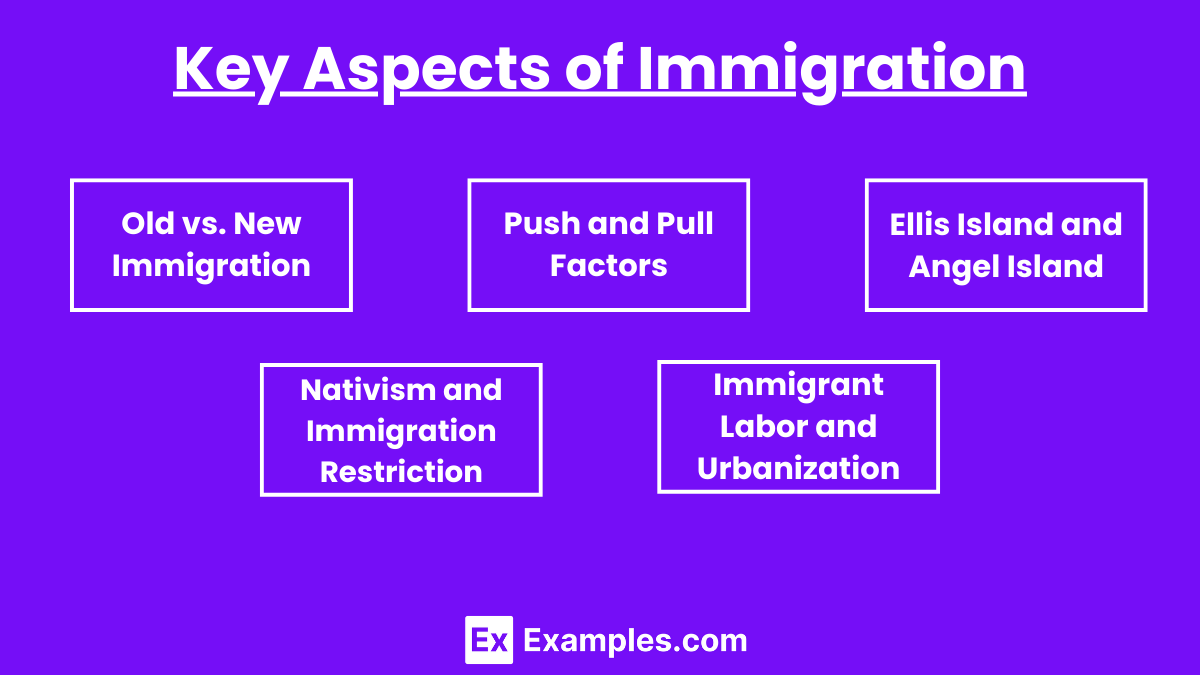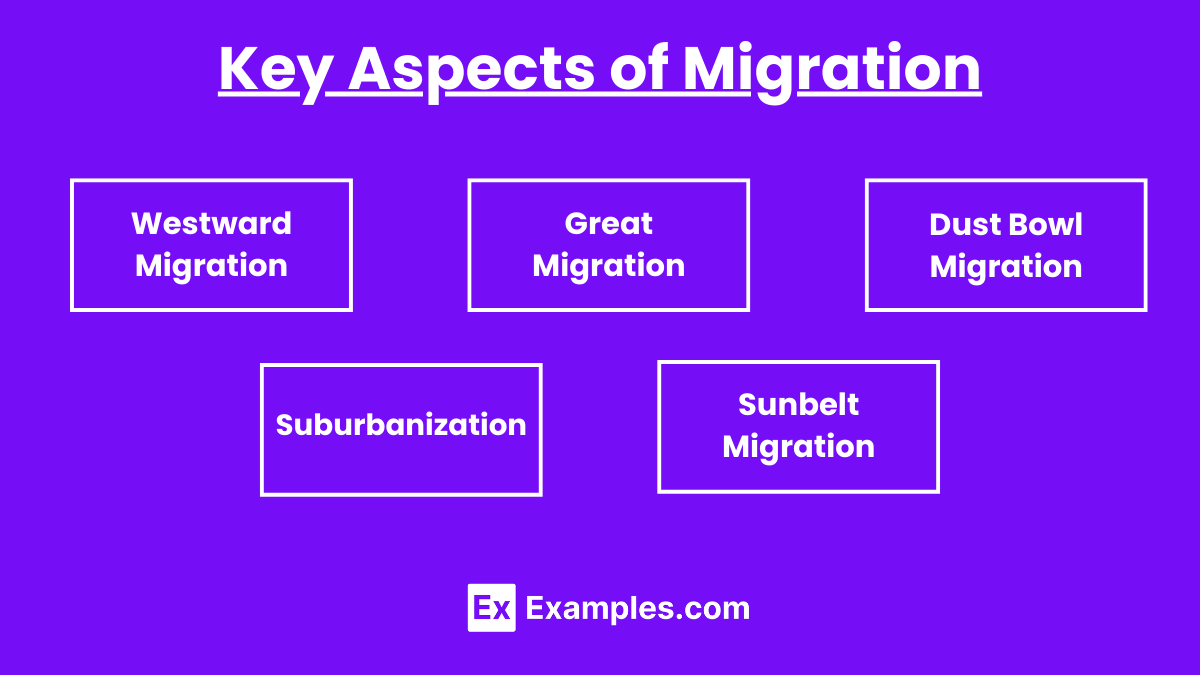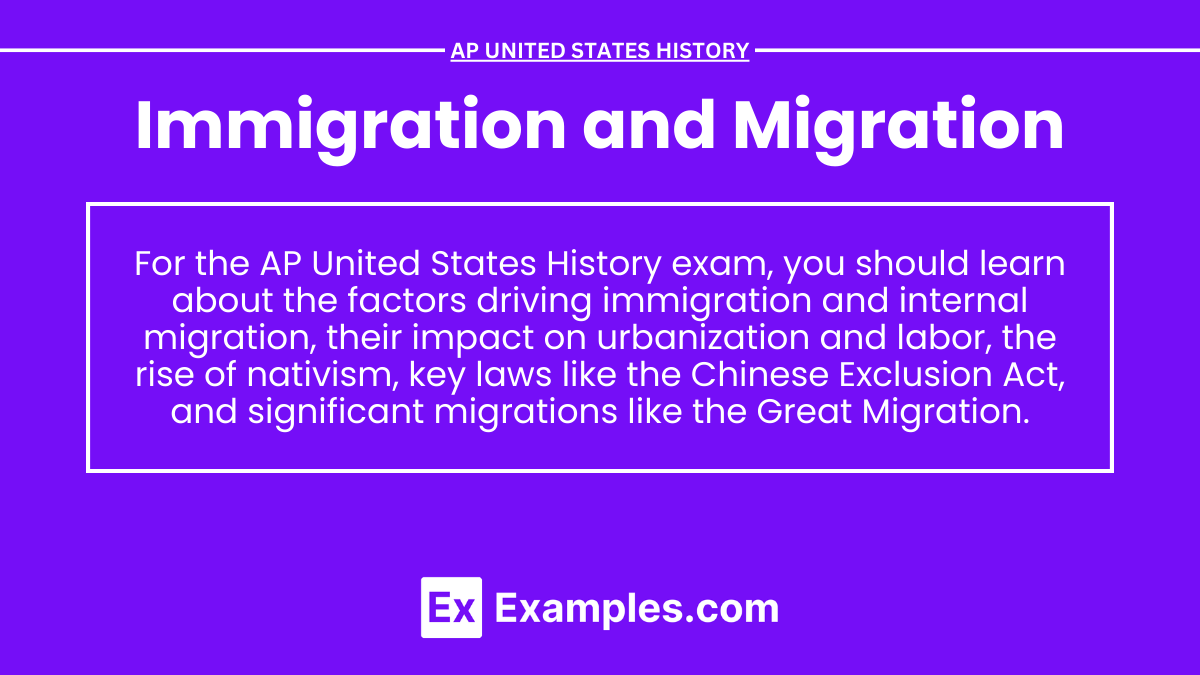In AP United States History, Immigration and Migration are key themes that highlight the movement of people both into and within the United States, shaping the nation’s demographic, economic, and cultural landscape. The late 19th and early 20th centuries saw large waves of immigrants from Europe, Asia, and other regions, while internal migrations, such as westward expansion and the Great Migration of African Americans, significantly impacted urbanization and regional development. These movements influenced labor, politics, and social dynamics, often leading to cultural tensions and calls for reform.
Learning Objectives
The learning objectives for the topic “Immigration and Migration” will include the ability to analyze the factors driving immigration and internal migration, such as economic opportunities and political unrest. You will be expected to evaluate the impact of these movements on American society, including urbanization, cultural tensions, and labor dynamics. Additionally, you will be required to understand the responses to immigration, including nativism and restrictive legislation, and assess the long-term effects on U.S. demographics and regional development.
Key Aspects of Immigration

- Old vs. New Immigration
- “Old” immigrants (before 1880) primarily came from Northern and Western Europe (e.g., Germany, Ireland, and Britain). “New” immigrants (after 1880) largely came from Southern and Eastern Europe (e.g., Italy, Poland, and Russia), as well as Asia. The cultural differences of “new” immigrants led to increased nativism and calls for immigration restriction.
- Push and Pull Factors
- Push factors such as economic hardship, political persecution, and religious discrimination drove people out of their home countries. Pull factors, including economic opportunities, land availability, and the promise of freedom, attracted them to the United States.
- Ellis Island and Angel Island
- Ellis Island in New York Harbor became the primary entry point for European immigrants, processing millions of arrivals between 1892 and 1954. Angel Island in San Francisco Bay served a similar role for Asian immigrants, who faced stricter entry requirements due to exclusionary laws like the Chinese Exclusion Act of 1882.
- Nativism and Immigration Restriction
- The rise of nativism led to efforts to restrict immigration, resulting in laws like the Chinese Exclusion Act (1882) and the Immigration Act of 1924, which established quotas based on national origins, favoring Northern and Western Europeans.
- Immigrant Labor and Urbanization:
- Immigrants played a crucial role in the U.S. economy, providing labor for factories, railroads, and mines. Many settled in rapidly growing urban areas, contributing to the expansion of cities but also facing poor living conditions, overcrowding, and labor exploitation.
Key Aspects of Migration

- Westward Migration:
- Driven by Manifest Destiny and economic opportunities, Americans moved westward during the 19th century, resulting in the displacement of Native American tribes and the settlement of new territories. Government policies like the Homestead Act of 1862 encouraged this migration.
- Great Migration:
- The Great Migration (1916-1970) saw millions of African Americans move from the rural South to Northern and Midwestern cities to escape Jim Crow laws and seek better economic opportunities. This migration significantly impacted urban demographics and culture, particularly in cities like Chicago, Detroit, and New York.
- Dust Bowl Migration:
- During the 1930s, severe droughts and dust storms in the Great Plains led to the displacement of thousands of farming families. Many migrated to California and other western states in search of work, as depicted in John Steinbeck’s The Grapes of Wrath.
- Suburbanization:
- Post-World War II saw a mass migration from cities to suburbs, facilitated by the GI Bill, affordable housing, and the expansion of the interstate highway system. This movement reshaped American demographics and led to the growth of suburban communities.
- Sunbelt Migration:
- In the late 20th century, there was a significant migration to the Sunbelt states (South and Southwest), driven by economic opportunities, warmer climates, and the rise of industries like aerospace and defense. This migration shifted political and economic power within the United States.
Examples
1. Ellis Island: Processed millions of European immigrants; symbol of American immigration.
2. Chinese Exclusion Act (1882): The first federal law to restrict immigration based on nationality, targeting Chinese laborers.
3. Great Migration: African Americans moved North, reshaping cities and culture.
4. Homestead Act (1862): Encouraged westward migration by offering free land to settlers.
5. Immigration Act of 1924: Established national origin quotas, favoring certain European immigrants over others.
MCQs
- Which island served as the primary entry point for European immigrants during the late 19th and early 20th centuries?
- A) Angel Island
- B) Staten Island
- C) Ellis Island
- D) Liberty Island
- Answer: C) Ellis Island
- Explanation: Ellis Island in New York Harbor was the main entry point for European immigrants, processing millions of arrivals between 1892 and 1954.
- The Great Migration primarily involved the movement of which group of people?
- A) European immigrants to the West Coast
- B) African Americans from the rural South to Northern cities
- C) Native Americans to reservations
- D) Mexicans to the Southwest
- Answer: B) African Americans from the rural South to Northern cities
- Explanation: The Great Migration was the movement of African Americans from the South to Northern and Midwestern cities to escape segregation and seek economic opportunities.
- Which law was the first to significantly restrict immigration based on nationality?
- A) Homestead Act
- B) Immigration Act of 1924
- C) Chinese Exclusion Act
- D) National Origins Act
- Answer: C) Chinese Exclusion Act
- Explanation: The Chinese Exclusion Act of 1882 was the first federal law to significantly restrict immigration based on nationality, specifically targeting Chinese laborers.


